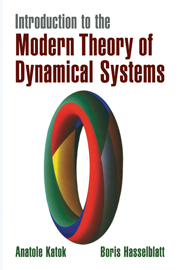Book contents
- Frontmatter
- Contents
- PREFACE
- 0 INTRODUCTION
- Part 1 Examples and fundamental concepts
- 1 FIRST EXAMPLES
- 2 EQUIVALENCE, CLASSIFICATION, AND INVARIANTS
- 3 PRINCIPAL CLASSES OF ASYMPTOTIC TOPOLOGICAL INVARIANTS
- 4 STATISTICAL BEHAVIOR OF ORBITS AND INTRODUCTION TO ERGODIC THEORY
- 5 SYSTEMS WITH SMOOTH INVARIANT MEASURES AND MORE EXAMPLES
- Part 2 Local analysis and orbit growth
- Part 3 Low-dimensional phenomena
- Part 4 Hyperbolic dynamical systems
- Appendix: BACKGROUND MATERIAL
- NOTES
- HINTS AND ANSWERS TO THE EXERCISES
- REFERENCES
- INDEX
5 - SYSTEMS WITH SMOOTH INVARIANT MEASURES AND MORE EXAMPLES
Published online by Cambridge University Press: 05 June 2012
- Frontmatter
- Contents
- PREFACE
- 0 INTRODUCTION
- Part 1 Examples and fundamental concepts
- 1 FIRST EXAMPLES
- 2 EQUIVALENCE, CLASSIFICATION, AND INVARIANTS
- 3 PRINCIPAL CLASSES OF ASYMPTOTIC TOPOLOGICAL INVARIANTS
- 4 STATISTICAL BEHAVIOR OF ORBITS AND INTRODUCTION TO ERGODIC THEORY
- 5 SYSTEMS WITH SMOOTH INVARIANT MEASURES AND MORE EXAMPLES
- Part 2 Local analysis and orbit growth
- Part 3 Low-dimensional phenomena
- Part 4 Hyperbolic dynamical systems
- Appendix: BACKGROUND MATERIAL
- NOTES
- HINTS AND ANSWERS TO THE EXERCISES
- REFERENCES
- INDEX
Summary
Certain classes of invariant measures are natural for smooth systems. Those are absolutely continuous measures, that is, measures that are given by densities in local coordinate charts. In the first section we establish general criteria for the existence of such measures in three classes of dynamical systems: discrete-time invertible and noninvertible and continuous-time invertible systems. We demonstrate how those criteria can be used to show existence and uniqueness for smooth invariant measures for expanding maps. In the rest of this chapter we describe several classes of dynamical systems that arise from classical mechanics and differential geometry. Due to the presence of an extra structure all these systems preserve a naturally defined smooth invariant measure. Along the way we enrich our collection of standard examples by a few interesting items.
Existence of smooth invariant measures
a. The smooth measure class. The Krylov–Bogolubov Theorem 4.1.1 establishes the existence of an invariant measure for any topological dynamical system on a compact metrizable space. Corollary 4.1.4 says that an invariant measure reflects the asymptotic behavior of almost all points with respect to that measure. Yet it is unclear just how much information this really gives. For example, if there is a periodic point, then one can consider the measure concentrated on the periodic orbit. It is invariant and trivially reflects the asymptotics of the periodic point, but gives no information about any other point.
- Type
- Chapter
- Information
- Introduction to the Modern Theory of Dynamical Systems , pp. 183 - 234Publisher: Cambridge University PressPrint publication year: 1995



